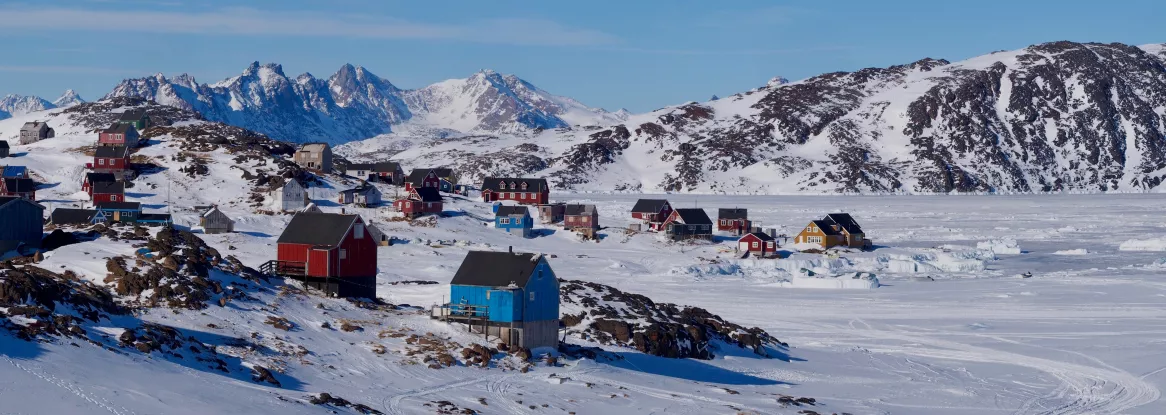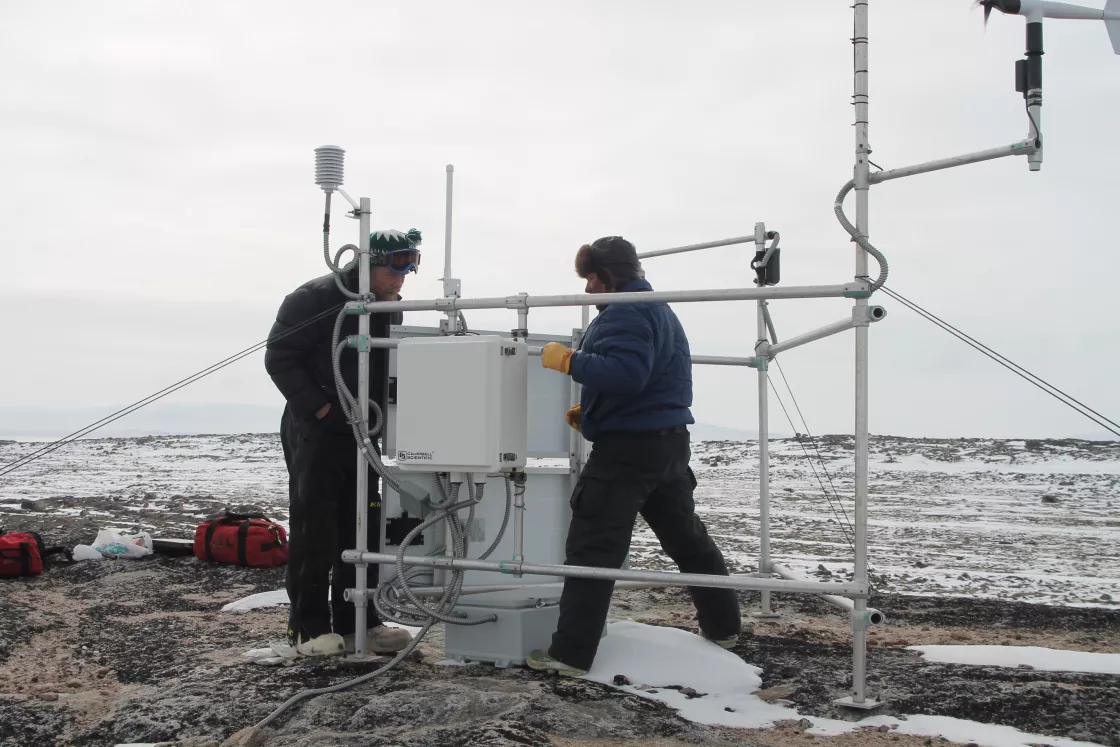Project summary
The Silalirijiit Project was an innovative effort to engage community members and stakeholders to better monitor and understand the weather of Baffin Island’s Clyde River region. It combined state-of-the-art weather-monitoring technology with local Inuit knowledge. The project was initiated by Shari Fox, then affiliated with NSIDC. The project began in 2009 and NSIDC’s involvement concluded in 2023. Funding came from multiple sources, predominantly the National Science Foundation, as well as Clyde River community members.
Background
The Inuit community of Kangiqtugaapik (Clyde River), Nunavut, on Baffin Island, Canada, maintains a strong subsistence culture, living off the land and ocean. Community members travel long distances to hunt seals, polar bears, and fish. Tracking weather and ice patterns in the area to decide where, when, and what they hunt is a tradition that has been passed down from generation to generation. In 2009, Shari Fox, then a researcher with NSIDC, worked with Clyde River residents to launch the Silalirijiit Project, which means ‘those who work with weather.’ This collaborative research project brought together hunters, Elders, and visiting scientists to support the community with better weather, snow, and ice information to set them up for safer travel and successful hunting.
This multidisciplinary, multicultural project increased the community’s access to weather information by establishing a modest weather station network and documenting Inuit knowledge of weather, weather indicators, and weather forecasting. It blended Inuit knowledge with climate science and environmental modeling to better understand changing weather patterns and human responses in the Clyde River area.
In addition to enhancing the detailed knowledge of the environment that Clyde River residents already possessed, this collaboration was vital to sustaining their ways of life. In recent decades, climate change has shifted weather patterns in this region, making the patterns more variable and extreme. With the added data and resources from the Silalirijiit Project, Clyde River residents could access information to make more informed decisions about travelling and hunting.
Meeting community needs with weather stations
In 2009, when the project began, instrumented weather data were sparse. The region’s only weather stations were located at widely scattered airports. This situation frequently resulted in inaccurate predictions because the topography of the region is complicated, and the airports are far from Inuit hunting locales. The Silalirijiit Project team realized they would need to bring more, better-placed weather stations to the area in order to provide more accurate weather information. Because the local hunters and Elders already had detailed, experience-based knowledge of the weather patterns in the area, the project team relied heavily on their input as to where the most useful locations for weather stations were. The team identified several locations to target, then installed the first weather station at Akuliaqattak, which is located about 70 kilometers (43 miles) north of Clyde River, in 2010. The project installed several additional weather stations, located at Silasiutitalik, Ailaktalik, and Nattiqsujuq, making near-real time weather data and information available to the public in Inuktitut, the Inuit language, and English.
The Silalirijiit Project team analyzed if, when, and how the weather station data would be used, finding that community members regularly accessed data, most often just before the weekend and when storms are in the forecast. Researchers, educators, tourism operators, pilots, and meteorologists also used the data. The community maintained the weather stations themselves, ensuring the skills to do so stayed within Clyde River.
Advancing and sharing weather information
In addition to installing and maintaining the weather stations, the Silalirijiit Project team also worked to advance other types of weather information for the community. Researchers worked with Elders and hunters to identify additional weather variables via modeling that would be more useful to the community than those identified in standard weather station data. Ocean wave height and visibility (e.g., blowing snow), for instance, are more useful to hunters than air temperature and humidity, because hunters must go out to hunt regardless of how cold the air may be. However, if visibility is too poor or the waves are too high, they may need to postpone or choose a different area to visit for safety reasons.
The project also supported land-skills training for youth at the request of the community. Young Inuit were given the opportunity to learn weather-related knowledge and skills from experienced hunters through an ongoing, daily hunting program. During the program, project team members documented how the instructors passed on weather knowledge to the younger generation in order to learn more about and document what Inuit knew about and practiced related to weather, how they forecast it, and how they understood weather changes. This information was being used to help develop the new weather models.
Collaboration across organizations and cultures
The core Silalirijiit Project team remained in place for the duration of the project, and members attributed the project’s success to close collaboration and genuine friendship between team members and the greater community. Led by Fox, the core team consisted of Esa Qillaq, Ilkoo Angutikjuak, Robert Kautuk, and DJ Tigullaraq of Clyde River, Glen Liston of Colorado State University, Kelly Elder of the US Forest Service, and Henry Huntington of Huntington Consulting.
Several sources funded the project through the years, including the National Science Foundation (NSF), the Government of Nunavut, and the Hamlet of Clyde River. Clyde River community members funded the stations themselves during a two-year gap in funding and retain long-term ownership of the project. NSF funding was granted through the Arctic Social Sciences Program, supporting research on past and present Arctic social and cultural systems and research relevant to understanding these systems.
Selected papers
Fox, S., E. Qillaq, I. Angutikjuak, D.J. Tigullaraq, R. Kautuk, H. Huntington, G.E. Liston, and K. Elder. 2020. Connecting understandings of weather and climate: steps towards co-production of knowledge and collaborative environmental management in Inuit Nunangat. Arctic Science 6(3), https://doi.org/10.1139/as-2019-0010.
Pulsifer, P., S. Gearheard, H.P. Huntington, M.A. Parsons, C. McNeave, and H.S. McCann. 2012. The role of data management in engaging communities in Arctic research: overview of the Exchange for Local Observations and Knowledge of the Arctic (ELOKA). Polar Geography 35(3–4): 271-290, https://doi.org/10.1080/1088937X.2012.708364.
Timeline
- 2009: The Silalirijiit Project begins.
- 2009: The first weather station sites are confirmed.
- 2010: The first weather station is installed at Akuliaqattak.
- 2013: The first Silalirijiit Project officially ends.
- 2014: Funding is secured through the Government of Nunavut to keep the weather stations running.
- 2015: Funding is secured through the Hamlet of Clyde River to continue operating the Clyde River weather station network.
- 2018: The project secures a new grant from the National Science Foundation: Working with Inuit Elders and Youth to Identify, Document, Quantify, and Share Human-Relevant Environmental Variables (HREVs) in Clyde River, Nunavut. Funding extends into 2023.

